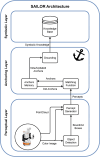SAILOR: perceptual anchoring for robotic cognitive architectures
- PMID: 39747469
- PMCID: PMC11697306
- DOI: 10.1038/s41598-024-84071-2
SAILOR: perceptual anchoring for robotic cognitive architectures
Abstract
Symbolic anchoring is an important topic in robotics, as it enables robots to obtain symbolic knowledge from the perceptual information acquired through their sensors and maintain the link between that knowledge and the sensory data. In cognitive-based robots, this process of transforming sub-symbolic data generated by sensors to obtain and maintain symbolic knowledge is still an open problem. To address this issue, this paper presents SAILOR, a framework for symbolic anchoring integrated into ROS 2. SAILOR aims to maintain the link between symbolic data and perceptual data in real robots over time. It provides a semantic world modeling approach using two deep learning-based sub-symbolic robotic skills: object recognition and matching function. The object recognition skill allows the robot to recognize and identify objects in its environment, while the matching function enables the robot to decide if new perceptual data corresponds to existing symbolic data. This paper describes the proposed method and the development of the framework, as well as its integration in MERLIN2 (a hybrid cognitive architecture fully functional in robots running ROS 2) and the validation of SAILOR using public datasets and a real-world scenario.
© 2024. The Author(s).
Conflict of interest statement
Declarations. Competing interests: The authors declare no competing interests. Ethics approval: The authors confirm that they have complied with the publication ethics and state that this work is original and has not been used for publication anywhere before.
Figures









References
-
- Ye, P., Wang, T. & Wang, F.-Y. A survey of cognitive architectures in the past 20 years. IEEE Trans. Cybern.48, 3280–3290 (2018). - PubMed
-
- Kotseruba, I. & Tsotsos, J. K. 40 years of cognitive architectures: Core cognitive abilities and practical applications. Artif. Intell. Rev.53, 17–94 (2020).
-
- Kotseruba, I., Gonzalez, O. J. A. & Tsotsos, J. K. A review of 40 years of cognitive architecture research: Focus on perception, attention, learning and applications. arXiv preprint arXiv:1610.08602 1–74 (2016).
-
- Fox, M. & Long, D. Pddl2. 1: An extension to pddl for expressing temporal planning domains. J. Artif. Intell. Res.20, 61–124 (2003).
-
- Quigley, M. et al. Ros: An open-source robot operating system. In ICRA Workshop on Open Source Software. Vol. 3. 5 (2009).
Grants and funding
LinkOut - more resources
Full Text Sources

